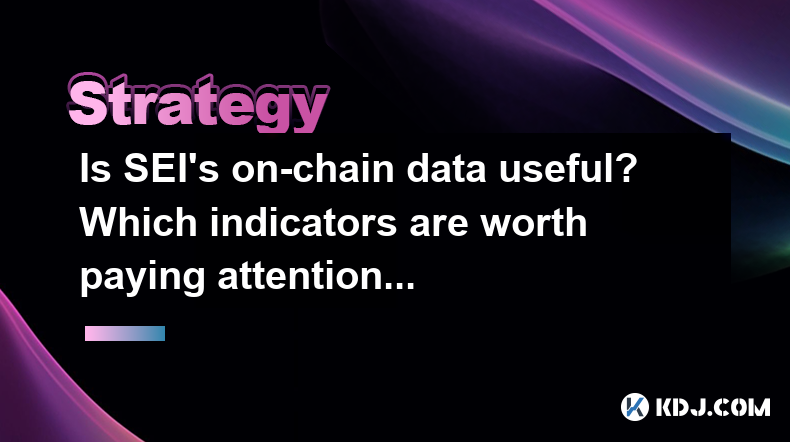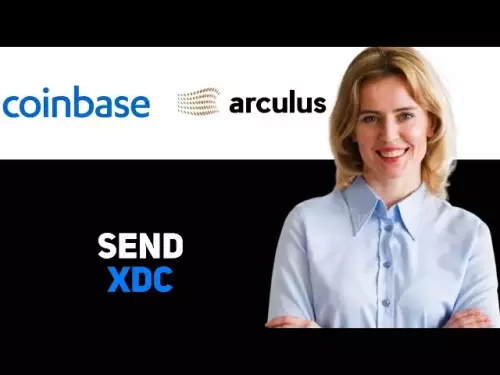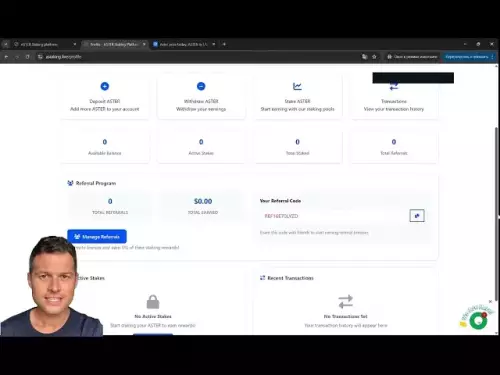-
 bitcoin
bitcoin $111375.742210 USD
-8.60% -
 ethereum
ethereum $3780.311592 USD
-13.98% -
 tether
tether $1.001299 USD
0.07% -
 bnb
bnb $1093.375857 USD
-13.01% -
 xrp
xrp $2.339375 USD
-16.91% -
 solana
solana $185.029017 USD
-16.69% -
 usd-coin
usd-coin $1.000230 USD
0.04% -
 tron
tron $0.319531 USD
-5.16% -
 dogecoin
dogecoin $0.190791 USD
-23.59% -
 cardano
cardano $0.638663 USD
-21.82% -
 ethena-usde
ethena-usde $0.998483 USD
-0.20% -
 hyperliquid
hyperliquid $37.741486 USD
-14.68% -
 chainlink
chainlink $17.229851 USD
-22.17% -
 stellar
stellar $0.316546 USD
-16.74% -
 bitcoin-cash
bitcoin-cash $507.861193 USD
-13.18%
Is SEI's on-chain data useful? Which indicators are worth paying attention to?
SEI's on-chain data, including transaction volume and active addresses, provides valuable insights into network performance and user engagement for informed decision-making.
May 05, 2025 at 01:43 am

Introduction to SEI and On-Chain Data
SEI, or Sei Network, is a layer-1 blockchain designed to enhance the efficiency of trading and decentralized finance (DeFi) applications. As with any blockchain, on-chain data offers valuable insights into the network's performance, user engagement, and overall health. Analyzing on-chain data can help investors, developers, and users make informed decisions. In this article, we will explore whether SEI's on-chain data is useful and identify which indicators are worth paying attention to.
The Importance of On-Chain Data
On-chain data is crucial for understanding the dynamics of a blockchain network. It provides transparent and verifiable information about transactions, user activity, and network performance. For SEI, on-chain data can reveal trends in user adoption, the popularity of specific applications, and the overall health of the ecosystem. By examining this data, stakeholders can gauge the network's growth and potential areas for improvement.
Key Indicators to Monitor on SEI
When assessing SEI's on-chain data, several indicators stand out as particularly useful. These include transaction volume, active addresses, block time, and gas fees. Each of these metrics offers a unique perspective on the network's performance and can help stakeholders make more informed decisions.
Transaction Volume
Transaction volume is a fundamental indicator of a blockchain's activity level. For SEI, monitoring transaction volume can provide insights into the network's usage and the popularity of its applications. High transaction volumes typically indicate a healthy and active ecosystem, while low volumes may suggest a lack of user engagement.
To track transaction volume on SEI, users can access various blockchain explorers and analytics platforms. These tools aggregate data from the blockchain and present it in an easily digestible format. For instance, users can use a blockchain explorer to view the total number of transactions over a specific period, allowing them to identify trends and patterns in network activity.
Active Addresses
Active addresses are another critical metric for assessing SEI's on-chain data. This indicator measures the number of unique addresses that are actively participating in transactions on the network. A high number of active addresses suggests a broad user base and strong engagement, which are positive signs for the network's growth and sustainability.
To monitor active addresses on SEI, users can utilize blockchain analytics platforms that provide real-time data on address activity. These platforms often offer customizable charts and graphs, allowing users to track changes in active addresses over time. By analyzing this data, stakeholders can gain insights into user behavior and the network's overall health.
Block Time
Block time is the average time it takes for a new block to be added to the blockchain. For SEI, monitoring block time can provide insights into the network's efficiency and scalability. Shorter block times generally indicate faster transaction processing and a more responsive network, which are crucial for applications that require quick transaction confirmations.
To track block time on SEI, users can refer to blockchain explorers that display real-time data on block creation. These explorers often include historical data, allowing users to compare current block times with past performance. By analyzing this data, stakeholders can assess the network's performance and identify potential areas for improvement.
Gas Fees
Gas fees are the costs associated with executing transactions on the blockchain. For SEI, monitoring gas fees can provide insights into the network's cost-effectiveness and user experience. High gas fees may deter users from engaging with the network, while low fees can attract more users and encourage greater activity.
To monitor gas fees on SEI, users can use blockchain explorers and analytics platforms that provide real-time data on transaction costs. These tools often include historical data, allowing users to track changes in gas fees over time. By analyzing this data, stakeholders can assess the network's cost-effectiveness and identify potential areas for optimization.
Practical Applications of SEI's On-Chain Data
SEI's on-chain data can be applied in various practical ways to benefit investors, developers, and users. For investors, analyzing on-chain data can help identify investment opportunities and assess the network's growth potential. By monitoring key indicators such as transaction volume and active addresses, investors can make more informed decisions about their investments.
For developers, on-chain data can provide valuable insights into user behavior and application performance. By analyzing transaction volume and gas fees, developers can identify areas for optimization and improve the user experience. Additionally, monitoring block time can help developers assess the network's scalability and plan for future growth.
For users, on-chain data can offer transparency and accountability. By accessing real-time data on transaction volume, active addresses, and gas fees, users can make more informed decisions about their interactions with the network. This transparency can enhance trust and encourage greater engagement with SEI's ecosystem.
How to Access and Analyze SEI's On-Chain Data
Accessing and analyzing SEI's on-chain data is relatively straightforward, thanks to various blockchain explorers and analytics platforms. Here are the steps to access and analyze this data:
- Choose a Blockchain Explorer or Analytics Platform: Start by selecting a reputable blockchain explorer or analytics platform that supports SEI. Popular options include Blockscout, Etherscan, and Dune Analytics.
- Navigate to SEI's Network: Once you have chosen a platform, navigate to the section dedicated to SEI's network. This section will provide access to real-time data and historical information about the blockchain.
- Select Key Indicators: Identify the key indicators you want to monitor, such as transaction volume, active addresses, block time, and gas fees. Most platforms allow users to customize their view and focus on specific metrics.
- Analyze the Data: Use the platform's tools to analyze the data and identify trends and patterns. Many platforms offer customizable charts and graphs, making it easier to visualize the data and draw insights.
- Draw Insights: Based on your analysis, draw insights about SEI's network performance and user engagement. Consider how these insights can inform your decisions as an investor, developer, or user.
Frequently Asked Questions
Q: Can on-chain data predict the future performance of SEI?A: While on-chain data can provide valuable insights into current trends and network performance, it cannot predict the future with certainty. However, by analyzing historical data and identifying patterns, stakeholders can make more informed predictions about potential future developments.
Q: How often should I check SEI's on-chain data?A: The frequency of checking SEI's on-chain data depends on your specific needs and goals. Investors may want to monitor key indicators daily or weekly to stay informed about market trends, while developers may check data more frequently to optimize their applications. Users can check data periodically to stay updated on network performance and transaction costs.
Q: Are there any tools that can automate the analysis of SEI's on-chain data?A: Yes, several tools and platforms offer automated analysis of on-chain data. For instance, platforms like Dune Analytics allow users to create custom dashboards and set up automated alerts for specific metrics. These tools can save time and provide real-time insights into SEI's network performance.
Q: How can I ensure the accuracy of SEI's on-chain data?A: To ensure the accuracy of SEI's on-chain data, it's essential to use reputable and well-established blockchain explorers and analytics platforms. Additionally, cross-referencing data from multiple sources can help verify its accuracy. Always be cautious of platforms that provide inconsistent or unreliable data.
Disclaimer:info@kdj.com
The information provided is not trading advice. kdj.com does not assume any responsibility for any investments made based on the information provided in this article. Cryptocurrencies are highly volatile and it is highly recommended that you invest with caution after thorough research!
If you believe that the content used on this website infringes your copyright, please contact us immediately (info@kdj.com) and we will delete it promptly.
- Bittensor (TAO): Super Bullish Signals Point to Potential 2x Rally
- 2025-10-11 10:25:12
- Silver Price Correction: Navigating the Dip & Identifying Key SEO Keywords
- 2025-10-11 10:25:12
- MoonBull: The Crypto Meme Coin Promising 1000x Gains?
- 2025-10-11 10:30:01
- Crypto Payroll Revolution: Stablecoins, Altcoins, and the Future of Salary Payments
- 2025-10-11 10:30:01
- Decoding Crypto Trends: XRP's Bitcoin Dream, BlockDAG's Rise, and the PayFi Revolution
- 2025-10-11 10:30:01
- Amina Bank & Polygon: Institutional Staking with a Sweet 15% Yield
- 2025-10-11 10:30:15
Related knowledge

Practical parameter settings for a Bitcoin multi-timeframe moving average system
Sep 18,2025 at 10:54pm
Optimizing Timeframe Combinations for Bitcoin Trading1. Selecting appropriate timeframes is crucial when building a multi-timeframe moving average sys...

How can I filter out false breakouts in Dogecoin high-frequency trading?
Sep 22,2025 at 01:00am
Understanding False Breakouts in Dogecoin Trading1. A false breakout occurs when Dogecoin's price appears to move beyond a defined support or resistan...

Techniques for identifying tops and bottoms in the Bitcoin on-chain NVT model
Sep 20,2025 at 07:54pm
Understanding the NVT Model in Bitcoin Analysis1. The Network Value to Transactions (NVT) ratio is often described as the 'P/E ratio' of the cryptocur...

What does the surge in open interest in Bitcoincoin futures mean?
Sep 20,2025 at 11:18pm
Understanding the Surge in Dogecoin Futures Open Interest1. A surge in open interest within Dogecoin futures indicates a growing number of active cont...

How can I use the Ethereum USDT premium to gauge market sentiment?
Sep 18,2025 at 11:55pm
Understanding the Ethereum USDT Premium1. The Ethereum USDT premium refers to the price difference between USDT (Tether) traded on Ethereum-based plat...

What should I do if Ethereum staking yields decline?
Sep 20,2025 at 06:18am
Understanding the Causes Behind Declining Ethereum Staking Yields1. The Ethereum network transitioned to a proof-of-stake consensus mechanism with the...

Practical parameter settings for a Bitcoin multi-timeframe moving average system
Sep 18,2025 at 10:54pm
Optimizing Timeframe Combinations for Bitcoin Trading1. Selecting appropriate timeframes is crucial when building a multi-timeframe moving average sys...

How can I filter out false breakouts in Dogecoin high-frequency trading?
Sep 22,2025 at 01:00am
Understanding False Breakouts in Dogecoin Trading1. A false breakout occurs when Dogecoin's price appears to move beyond a defined support or resistan...

Techniques for identifying tops and bottoms in the Bitcoin on-chain NVT model
Sep 20,2025 at 07:54pm
Understanding the NVT Model in Bitcoin Analysis1. The Network Value to Transactions (NVT) ratio is often described as the 'P/E ratio' of the cryptocur...

What does the surge in open interest in Bitcoincoin futures mean?
Sep 20,2025 at 11:18pm
Understanding the Surge in Dogecoin Futures Open Interest1. A surge in open interest within Dogecoin futures indicates a growing number of active cont...

How can I use the Ethereum USDT premium to gauge market sentiment?
Sep 18,2025 at 11:55pm
Understanding the Ethereum USDT Premium1. The Ethereum USDT premium refers to the price difference between USDT (Tether) traded on Ethereum-based plat...

What should I do if Ethereum staking yields decline?
Sep 20,2025 at 06:18am
Understanding the Causes Behind Declining Ethereum Staking Yields1. The Ethereum network transitioned to a proof-of-stake consensus mechanism with the...
See all articles










































































